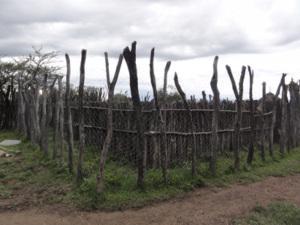 Seeing majestic lions strolling along the Maasai Mara at sunset — a dream vision for many conservationists, but a nightmare for pastoralists trying to keep their cattle safe at night. Fortunately a conservation success story from Kenya, published today in the journal Conservation Evidence, shows that predation of cattle can be reduced by almost 75% by constructing chain-link livestock fences.
Seeing majestic lions strolling along the Maasai Mara at sunset — a dream vision for many conservationists, but a nightmare for pastoralists trying to keep their cattle safe at night. Fortunately a conservation success story from Kenya, published today in the journal Conservation Evidence, shows that predation of cattle can be reduced by almost 75% by constructing chain-link livestock fences.
The Anne K. Taylor Fund (AKTF) subsidises over 70% of the cost of building a fully fortified chain-link livestock enclosure (‘boma’) to keep cattle safe from predators at night, in the hope that this will lessen the retaliatory killings of lions by frustrated farmers. While lions, leopards and cheetahs draw in crowds of tourists who marvel at their strength and beauty, living alongside big predators can be tough. Traditionally, local people keep their animals overnight in bomas made of acacia thorns — but depredation by lions and other large carnivores cause losses of on average more than nine head of cattle per year, or US$1870 that farmers see disappear down the throat of big, hairy animals. Building a solid fortification of chain-link fence costs just $890, of which the AKTF paid $638, helping to make this an affordable option for hard-pressed locals.

Fortified boma
These ‘fortified’ bomas more than paid for themselves over a single year — on average fortified bomas suffered losses to predators such as lions and hyaenas of under $500 per year, about a quarter of the losses seen from traditional acacia thorn bomas. Researchers found that 67% of fortified bomas suffered absolutely no livestock losses, compared to just 15% of unfortified bomas whose owners were so lucky.
Even partially fortifying a boma, by wrapping chain link around the acacia scrub, helped farmers to reduce losses to just $641 per year. Partially fortifying bomas costs half the price of full fortification — just $125 after the AKTF has provided a subsidy — and takes less than a day to complete as compared to at least two days to build a fully fortified boma. This is a cost-effective means to reduce livestock losses where materials or labor are scarce, where farmers cannot afford full fortification, or in the absence of a long-term commitment by an organisation like the AKTF that can offer subsidies and transport materials to where they are required.

Traditional acacia-thorn boma
In a region like the Western Mara, which has literacy rates of just 46% for men and 35% for women, reducing cattle losses could enable families that are wholly dependent on farming to sleep a little easier in their beds.
By fortifying their bomas, they know that their chances of suffering costly losses to their cattle, their main form of capital, has been greatly reduced. The next step is to see whether this increased security reduces the killing of lions, which occupy just 30% of their historic range, with many small populations heading for extinction in the next thirty years.
People and large carnivores often coexist rather uneasily, with carnivores increasingly coming off worse; conservation work such as this is critical for conserving the spectacular species that inspire so many people, while ensuring that the people living alongside them do not suffer threats to their livelihoods. The Ann K. Taylor Fund has already helped pastoralists to fortify 750 bomas, and with more donations, will be able to fortify many more.
This study shows the importance of testing conservation work, and calculating the costs; the impressive data on money saved will doubtless persuade many more farmers of the benefits of fortification.

Lead author Alexa with the skull of a lion-killed buffalo

